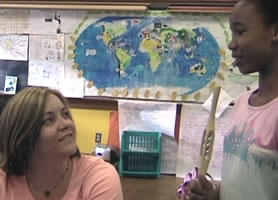 Almanacs and Inquiry:
Almanacs and Inquiry:
Almanacs as Springboards to Inquiry
Ms. K is a bright, young teacher eager to help her students wonder and explore, yet conclude with a learning focus. She challenges her students to think critically and creatively.
“Students and teachers pose questions and in seeking answers, generate new questions. The questions posed matter to us, coming from personal connections and observations of our world. This process of generating questions, instead of eliminating them, leads to exploration, investigation, and more questions.” (IPS Center for Inquiry)
The walls of Ms. K's classroom reflect this inquiry-based approach. As students explore areas of study, they begin creating storyboards, charts, photographs, maps, collages, and other visuals to brainstorm their thoughts, organize their ideas or express their understandings. Posted on the floors, walls, and ceilings, these "works in progress" are often collaboratively created and evolve throughout the school year. These living walls become reflections of the minds of active, thoughtful students. As a result, children are constantly engaged in constructing knowledge, building on the work of others, and reflecting on their accomplishments.
Almanac Discovery
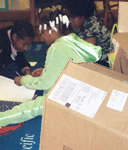 In the Winter of 2007, children in Ms. K's fifth/sixth grade class opened boxes of almanacs on a wide variety of topics including art, sports, politics, science, inventions, women leaders, minority leaders, presidents, pop culture, geography and more. They were enthralled by the range of topics and information. While some of the students were already familiar with almanacs, others were new to this type of reference resource.
In the Winter of 2007, children in Ms. K's fifth/sixth grade class opened boxes of almanacs on a wide variety of topics including art, sports, politics, science, inventions, women leaders, minority leaders, presidents, pop culture, geography and more. They were enthralled by the range of topics and information. While some of the students were already familiar with almanacs, others were new to this type of reference resource.
Traditionally, school librarians and classroom teachers have used a "worksheet" approach to teaching about almanacs. Students might be asked to find the "longest river in the world" or list the largest cities in the world leaving children to think that almanacs are more like "test answer keys" than exciting tools for learning.
Ms. K took a different approach. Instead of assigning trivia questions, she asked students to dive into the resources and explore those things they found of most interest. From inventors and sport figures to fashion and travel, the classroom was alive with discovery.
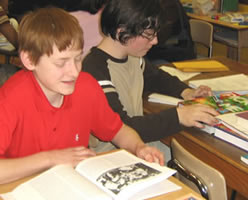

 To frame their exploration, children were provided with guided questions to help them become familiar with the features such as: [1]
To frame their exploration, children were provided with guided questions to help them become familiar with the features such as: [1]
- What is an almanac?
- Why might an almanac be useful or of interest to me?
- What can be found in an almanac that would be hard to find in other books?
- If my classmates and I were to make an almanac, how would we do it?
- Would we use old information or can we create our own information?
- Would anyone else care to know what we learn? Would they find it useful? Would they understand it?
 View A Passion for Learning (:27).
View A Passion for Learning (:27).
A child describes her favorite almanac. You can hear the passion for learning in her voice.
Digging Deeper
 Each student created a scavenger hunt for a particular almanac. They were encouraged to develop deep questions that asked "how" or "why" rather than simply "find the fact".
Each student created a scavenger hunt for a particular almanac. They were encouraged to develop deep questions that asked "how" or "why" rather than simply "find the fact".
To dig deeper into each book, the students completed each others hunts. They developed the rules for the hunt, so they could ask questions and give clues about where to find the information, or not, whatever they chose. This open-ended activity was a wonderful way to learn about almanacs.
The children discussed what they noticed about almanacs and created a place for them in the room.
 View Almanacs and World Records (:53).
View Almanacs and World Records (:53).
A child describes why she likes almanacs.
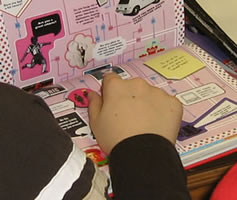 Writer's Workshop Genre Study
Writer's Workshop Genre Study
As part of a Writer's Workshop genre study, the students created a Features of Almanacs visual organizer.
While reviewing almanacs, the group kept a list of characteristics they wanted to include in their almanac such as design, art, humor, questions, links and whatever the children thought was most intriguing.
Ms. K noted that the class did a "fantastic job brainstorming ideas, better than I thought they would and they are MORE than excited to get started. I'm VERY impressed with today's discussion. The kids are really sounding articulate using vocabulary like: categories, facts, opinions, perspectives, chronological, survey, interests, historical, measure, calculate, just to name a few."
Features of Almanacs
Students generated a list of things that can be found in almanacs:
 Cartoons
Cartoons- Categories
- Changes over the year
- Data
- Definitions
- Diagrams
- Digging deeper into ideas
- Editorials
- Examples
- Explanations
- Facts
- Featured people and events
- Glossary
- Illustrations
- Indexes
- Maps
- Opinions
- Photographs
- Questions
- Quotes
- Records
- Reports
- Special achievements
- Step-by-step instructions
- Stories
- Table of Contents
- Time lines
- Tips and advice
- Top 10, Most, Worst
- Weather
 View Features of Almanacs (:29).
View Features of Almanacs (:29).
A child describes the features of an almanac.
Questions for Deep Thinking
 The children created a list of questions to help them dig deeper into the content of almanacs.
The children created a list of questions to help them dig deeper into the content of almanacs.
- Does the author use humor to make book interesting?
- How does author make book interesting?
- How does author use illustrations to help further understanding?
- What kind of facts does the author use?
- Who is the intended audience?
- How does the author gather information?
- How does the author decide what's important?
- Where did author get information?
- Does the author include opinions?
- How does the author organize information?
- Other than text, what else does the author include?
 View Almanacs and Timeliness (:36).
View Almanacs and Timeliness (:36).
A child describes his favorite almanac and the elements that make it effective.
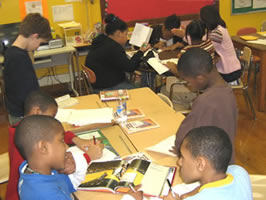 Almanacs and Inquiry
Almanacs and Inquiry
The framework for inquiry includes: [1]
- the opportunity to explore resources and raise questions
- the practice in gathering information and expressing individual findings on a basic project
- to consider the components of a common class project and a role each student could play
- a strategy for gathering and presenting new information as a group
- compiling and displaying the information for others to access and appreciate
 Once students were familiar with the almanacs, Ms. K introduced two inquiry experiences. As a class, the children would collect data, organize information, create illustrations, and build their own class almanac. At the same time, students would conduct personal inquiries into a topic of their choice using the many almanac resources.
Once students were familiar with the almanacs, Ms. K introduced two inquiry experiences. As a class, the children would collect data, organize information, create illustrations, and build their own class almanac. At the same time, students would conduct personal inquiries into a topic of their choice using the many almanac resources.
As the project progressed, Ms. K added a third experience related to Culture Study. The almanacs were a practical tool for locating information to support an exploration of culture and geography.
To see a visual representation of the progression of the project, download the Almanacs in Room 21 PDF document.
Go to the School Almanac page to learn more about the next phase of the project.

